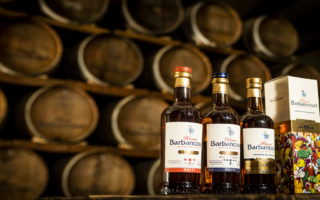Exploring Languedoc’s wine country
Out of the shadow of Carcassonne’s medieval turrets, Languedoc’s vineyards are emerging into a brighter future. Dominic Rippon pays a visit.
I first met Laurent Delaunay in 2008. The recession had started to bite in the UK and wine merchants were among the first to feel its teeth. As sales faltered, we wine buyers scrambled to offer keenly priced wines without sacrificing quality. Our customers were fans of southern French wines, so when value was required, all roads led us to Languedoc-Roussillon.
Originally from a family of Burgundy négociant winemakers, Laurent and his wife Catherine began making wine in the Languedoc in the mid-1990s. In 2005, they bought a winery called Abbotts in the village of Marseillette, a few kilometres east of Carcassonne. Its previous owners were an Australian winemaking couple who had fallen on hard times, so when they sold their winery, Laurent and Catherine acquired a large cellar of fine vintages that stretched back to its establishment in 1996.
While he set about creating his own blends, Laurent was keen to sell existing stock: pallet-loads of bottle-aged Minervois, Faugères and Corbières, which buyers snapped up and offered to customers at low prices. Eventually the old stocks were exhausted and new samples – the wines made by Laurent and Catherine – began to arrive. I loved their bold, concentrated flavours, but in a reflection of the Languedoc’s broader fortunes, I knew that customers would hesitate to pay full price for wines they had become used to buying on discount.
So I felt a little sheepish, five years on, as I sipped rosé with Laurent on a sunny restaurant terrace in Carcassonne’s medieval cité. I hoped that the wines had found their niche in the UK market and was glad to learn that the world had moved on since 2008. The new Abbotts wines were selling well, Laurent reassured me, with a host of gold medals and trophies. “When we took over, we aimed for continuity of style, but we gradually moved towards our own, more traditional flavours,” he explained. “By 2010, we had perfected the balance, so we changed the name to Abbotts & Delaunay.”
Carcassonne sits at a viticultural crossroads, between some of the Languedoc’s most famous wine appellations – with Limoux to the south, Corbières to the south-east, Cabardès to the north, Minervois to the north-east and Malepère to the west – and we were joined by Laurent’s new winemaker, Hilde Chevillot, for a visit to the nearby vineyards. We passed beneath the windswept slopes that produce Abbotts’ Nuages et Vents (clouds and winds) range of single-vineyard wines, before descending towards the winery in Marseillette.
Situated on the Canal du Midi, on the border between the Corbières mountains and the gentler Minervois hills to the north, Marseillette is a magnet for wine enthusiasts. “This is the only place in France,” Laurent told me, “where the baker sells more wine than bread!” The village is home to a fashionable local radio station and even boasts its own culinary speciality, riz rose de Marseillette. This ‘pink rice’ is grown alongside grape vines and vegetables in the Étang de Marseillette, an ancient salt-water lake that was drained in the 19th century, when the flow of the River Aude was diverted to allow fresh-water irrigation for crops.
At the winery, Laurent uncorked a selection of sturdy bottles from the Nuages et Vents range, including the white Zéphyr Limoux 2012, a chardonnay which must be fermented and aged in oak to qualify for the Limoux appellation. Its flavours were deliciously mineral, reminding me of ripe white burgundy, but with the unmistakeable soft fruits of southern France. Then we compared Cumulo Nimbus Minervois – a blend of syrah and carignan – with Alto Stratus 2011. Although the latter also comes from within the Minervois growing area, it is made with 100 per cent carignan grapes (Minervois wines must be blended), and is therefore simply labelled Vin de France. Cumulo Nimbus showed off its refined syrah character with blackberry, bramble and liquorice flavours, while Alto Stratus gave hints of sour cherry, wild herb, raspberry and rhubarb, with a pleasantly astringent tannic bite.
We returned to Carcassonne, where a feast awaited us at the Restaurant La Barbacane. I chatted to Laurent about how much the Languedoc’s wines had improved over the past decade, as the area under vine had decreased and work had become concentrated on the better-quality vineyards. This revolution has been spearheaded by winemakers such as Laurent and Catherine Delaunay, and while the average price of their wines has increased to more sustainable levels, they remain some of the best-value bottles in France.
Share to: Facebook Twitter LinkedIn Email


